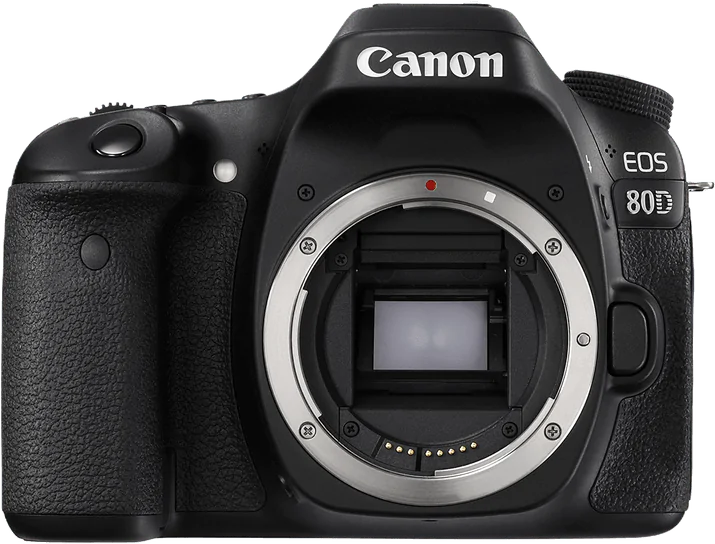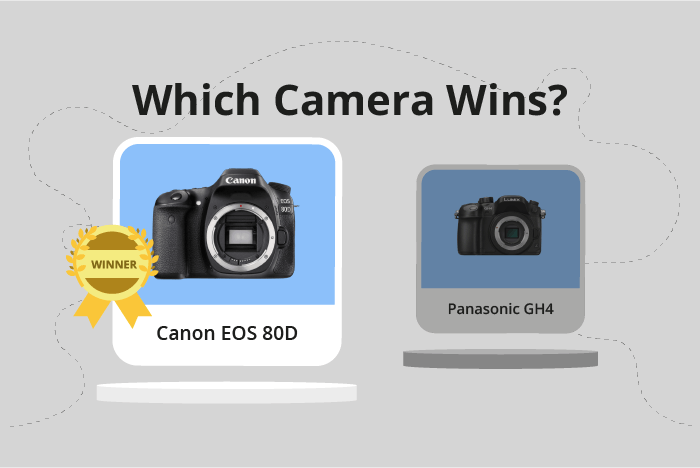Canon EOS 80D vs Panasonic Lumix DMC-GH4 Comparison
Canon EOS 80D

Panasonic Lumix DMC-GH4

The Canon EOS 80D takes the lead with a score of 64/100, while the Panasonic Lumix DMC-GH4 trails behind at 58/100. Both cameras share common features, such as their release years in the mid-2010s and their respective launch prices of $1200 and $1700.
The EOS 80D outperforms the GH4 due to its DSLR camera type, larger size (139 x 105 x 79mm), and heavier weight (730g / 1.61lbs). These specs contribute to its better overall performance and user experience.
On the other hand, the GH4 has its advantages as a mirrorless camera, with a more compact size (133 x 93 x 84mm) and lighter weight (560g / 1.23lbs), making it easier to carry around. However, these benefits do not outweigh the superior performance of the Canon EOS 80D.
Taking all factors into consideration, the Canon EOS 80D emerges as the better camera choice due to its higher score and improved specifications.
Canon EOS 80D vs Panasonic Lumix DMC-GH4 Overview and Optics
The Canon EOS 80D outperforms the Panasonic Lumix DMC-GH4 in optics, scoring 63/100 compared to the GH4’s 52/100. Both cameras share some common specifications, such as having a CMOS sensor, no image stabilization, and similar processors (Digic 6 for the 80D and Venus Engine IX for the GH4).
The EOS 80D excels with its 24.2-megapixel sensor, APS-C sensor size, and Canon EF-S lens mount. These features contribute to its higher DXOMARK sensor score of 79, providing better image quality and more versatility in lens options. Moreover, the 80D has a 3:2 aspect ratio, which is more suitable for printing photos and is the standard aspect ratio for most DSLR cameras.
On the other hand, the Lumix GH4 has a 16-megapixel sensor, Micro Four Thirds sensor size, and Micro 4/3 lens mount. Despite its lower DXOMARK sensor score of 74, the GH4 offers a faster shooting speed of 12 frames per second, compared to the 80D’s 7 frames per second. This advantage makes the GH4 more suitable for capturing fast-moving subjects or continuous shooting. The GH4 also features a 4:3 aspect ratio, which is more common among mirrorless cameras and offers a taller frame.
In terms of optics, the Canon EOS 80D offers superior image quality, sensor size, and lens compatibility, making it the better choice for photographers seeking high-quality images. However, the Panasonic Lumix DMC-GH4’s faster shooting speed may appeal to those who prioritize capturing fast action or continuous shooting. Ultimately, the choice between these two cameras will depend on the specific needs and preferences of the photographer.
Canon EOS 80D vs Panasonic Lumix DMC-GH4 Video Performance
The Canon EOS 80D and Panasonic Lumix DMC-GH4 both have a video score of 70/100, indicating that they are evenly matched in terms of video capabilities. Both cameras feature time-lapse functionality built in, which is a useful feature for capturing stunning time-lapse videos.
However, the Panasonic Lumix DMC-GH4 has an edge in terms of maximum video resolution and dimensions. It is capable of shooting 4K video with dimensions of 4096 x 2160, while the Canon EOS 80D is limited to Full HD with dimensions of 1920 x 1080. This means that the GH4 can capture more detail and produce higher quality video footage than the EOS 80D.
On the other hand, the Canon EOS 80D boasts a higher maximum video frame rate of 60fps, compared to the GH4’s 24fps. This allows the EOS 80D to capture smoother footage, particularly in fast-paced action scenes or when shooting slow-motion videos.
Taking these factors into consideration, it can be said that the Panasonic Lumix DMC-GH4 is better for shooting high-resolution videos with more detail, while the Canon EOS 80D is better suited for capturing smooth, fast-paced action. Ultimately, the choice between these two cameras depends on the user’s priorities and specific video requirements.
Canon EOS 80D vs Panasonic Lumix DMC-GH4 Features and Benefits
The Canon EOS 80D and the Panasonic Lumix DMC-GH4 both earn a feature score of 70/100. These cameras share several specifications, making them comparable in terms of features. Both cameras have a 3-inch screen, touchscreen capabilities, flip screens, and WIFI connectivity. Neither camera has GPS or Bluetooth capabilities.
The Canon EOS 80D has a slightly higher screen resolution at 1,040,000 dots compared to the Panasonic Lumix DMC-GH4’s 1,036,000 dots. This difference in screen resolution provides a marginally clearer and sharper image preview on the EOS 80D. However, this minor advantage may not significantly impact the overall user experience for most photographers.
On the other hand, the Panasonic Lumix DMC-GH4 stands out in its video capabilities, which were discussed in the previous section. The GH4’s ability to record 4K video at higher frame rates makes it more suitable for videographers and those who need advanced video features. This advantage sets the GH4 apart from the EOS 80D, which has lower video capabilities.
Considering the features of both cameras, it is clear that they are evenly matched in many aspects. The Canon EOS 80D has a slight edge in screen resolution, while the Panasonic Lumix DMC-GH4 excels in video capabilities. Ultimately, the choice between these two cameras will depend on the specific needs and preferences of the photographer. Those who prioritize video performance may opt for the GH4, while the 80D’s marginally better screen resolution may appeal to some photographers.
Canon EOS 80D vs Panasonic Lumix DMC-GH4 Storage and Battery
The Panasonic Lumix DMC-GH4 outperforms the Canon EOS 80D in storage and battery with a score of 60 to 43. Both cameras share similarities, such as accepting SD, SDHC, and SDXC memory cards, and not supporting USB charging. However, the GH4 takes the lead with two memory card slots compared to the 80D’s single slot, allowing for more storage flexibility.
The 80D offers a longer battery life of 960 shots, which is almost double the GH4’s 500 shots. Despite this advantage, the GH4’s overall storage and battery score remains higher. This is due to its dual memory card slots, which provide a significant advantage for photographers who require ample storage space.
While the Canon EOS 80D has a longer battery life, the Panasonic Lumix DMC-GH4’s dual memory card slots make it the superior choice for storage and battery capabilities.
Alternatives to the Canon EOS 80D and Panasonic Lumix DMC-GH4
Are you still undecided about which camera is right for you? Have a look at these popular comparisons that feature the Canon EOS 80D or the Panasonic Lumix DMC-GH4:

